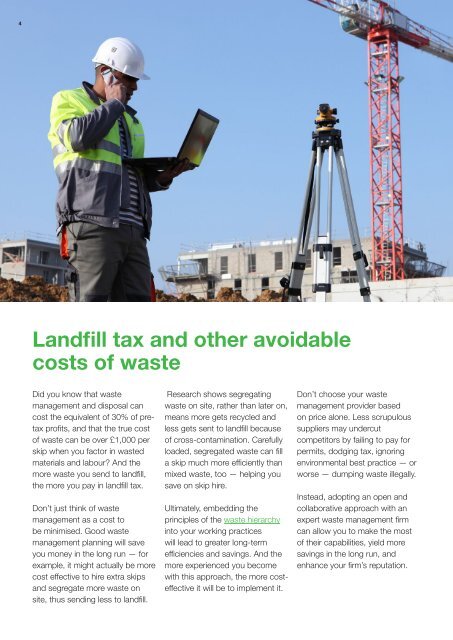how-to-control-the-risks-and-the-costs-v3
Create successful ePaper yourself
Turn your PDF publications into a flip-book with our unique Google optimized e-Paper software.
4 How <strong>to</strong> Control <strong>the</strong> Risks <strong>and</strong> <strong>the</strong> Costs of Waste Management<br />
5<br />
Keeping skips <strong>and</strong> waste containers<br />
in good condition<br />
L<strong>and</strong>fill tax <strong>and</strong> o<strong>the</strong>r avoidable<br />
<strong>costs</strong> of waste<br />
Faulty or damaged skips <strong>and</strong><br />
containers pose a major health <strong>and</strong><br />
safety risk on site. Site operatives<br />
should be aware of <strong>how</strong> <strong>to</strong><br />
judge <strong>the</strong> condition of skips <strong>and</strong><br />
containers, <strong>and</strong> <strong>how</strong> <strong>to</strong> identify<br />
potentially dangerous faults.<br />
For skips, this includes <strong>the</strong><br />
welding on external corners <strong>and</strong><br />
edges, whe<strong>the</strong>r internal welding<br />
is required (for extra heavy duty<br />
skips), <strong>the</strong> reinforcement of upper<br />
edges, <strong>the</strong> design of lifting lugs,<br />
<strong>and</strong> <strong>the</strong> condition of locking<br />
devices on drop-down doors.<br />
For waste containers, it includes<br />
<strong>the</strong> welding of key elements,<br />
reinforcement of high stress areas<br />
in extra heavy duty containers,<br />
<strong>the</strong> strength <strong>and</strong> design of locks,<br />
<strong>the</strong> reinforcement of upper edges,<br />
<strong>and</strong> <strong>the</strong> strength of door holdback<br />
restraints. Containers for hook<br />
loaders should have subframes<br />
designed <strong>and</strong> built <strong>to</strong> <strong>the</strong> correct<br />
industry st<strong>and</strong>ards.<br />
While you aren’t legally required<br />
<strong>to</strong> examine skips under Lifting<br />
Operations <strong>and</strong> Lifting Equipment<br />
Regulations (LOLER), you do need<br />
<strong>to</strong> ensure <strong>the</strong>y are in good repair<br />
under Provision <strong>and</strong> Use of Work<br />
Equipment Regulations (PUWER).<br />
Lifting equipment for skip loaders<br />
<strong>and</strong> hook loaders needs <strong>to</strong> be<br />
inspected by a competent person<br />
once a year under LOLER.<br />
Faulty skips <strong>and</strong> containers should<br />
be removed from site, whe<strong>the</strong>r<br />
for repair or disposal. While <strong>the</strong>re<br />
are no m<strong>and</strong>a<strong>to</strong>ry st<strong>and</strong>ards<br />
for skips <strong>and</strong> containers, <strong>the</strong><br />
Container H<strong>and</strong>ling Equipment<br />
Manufactures Association (CHEM)<br />
has developed voluntary industry<br />
st<strong>and</strong>ards.<br />
The Waste Industry Safety &<br />
Health Forum (WISH) has also<br />
produced a guide <strong>to</strong> skip <strong>and</strong><br />
container safety, which includes<br />
safety checklists <strong>and</strong> a guide <strong>to</strong><br />
relevant legislation <strong>and</strong> st<strong>and</strong>ards.<br />
Did you know that waste<br />
management <strong>and</strong> disposal can<br />
cost <strong>the</strong> equivalent of 30% of pretax<br />
profits, <strong>and</strong> that <strong>the</strong> true cost<br />
of waste can be over £1,000 per<br />
skip when you fac<strong>to</strong>r in wasted<br />
materials <strong>and</strong> labour? And <strong>the</strong><br />
more waste you send <strong>to</strong> l<strong>and</strong>fill,<br />
<strong>the</strong> more you pay in l<strong>and</strong>fill tax.<br />
Don’t just think of waste<br />
management as a cost <strong>to</strong><br />
be minimised. Good waste<br />
management planning will save<br />
you money in <strong>the</strong> long run — for<br />
example, it might actually be more<br />
cost effective <strong>to</strong> hire extra skips<br />
<strong>and</strong> segregate more waste on<br />
site, thus sending less <strong>to</strong> l<strong>and</strong>fill.<br />
Research s<strong>how</strong>s segregating<br />
waste on site, ra<strong>the</strong>r than later on,<br />
means more gets recycled <strong>and</strong><br />
less gets sent <strong>to</strong> l<strong>and</strong>fill because<br />
of cross-contamination. Carefully<br />
loaded, segregated waste can fill<br />
a skip much more efficiently than<br />
mixed waste, <strong>to</strong>o — helping you<br />
save on skip hire.<br />
Ultimately, embedding <strong>the</strong><br />
principles of <strong>the</strong> waste hierarchy<br />
in<strong>to</strong> your working practices<br />
will lead <strong>to</strong> greater long-term<br />
efficiencies <strong>and</strong> savings. And <strong>the</strong><br />
more experienced you become<br />
with this approach, <strong>the</strong> more costeffective<br />
it will be <strong>to</strong> implement it.<br />
Don’t choose your waste<br />
management provider based<br />
on price alone. Less scrupulous<br />
suppliers may undercut<br />
competi<strong>to</strong>rs by failing <strong>to</strong> pay for<br />
permits, dodging tax, ignoring<br />
environmental best practice — or<br />
worse — dumping waste illegally.<br />
Instead, adopting an open <strong>and</strong><br />
collaborative approach with an<br />
expert waste management firm<br />
can allow you <strong>to</strong> make <strong>the</strong> most<br />
of <strong>the</strong>ir capabilities, yield more<br />
savings in <strong>the</strong> long run, <strong>and</strong><br />
enhance your firm’s reputation.


